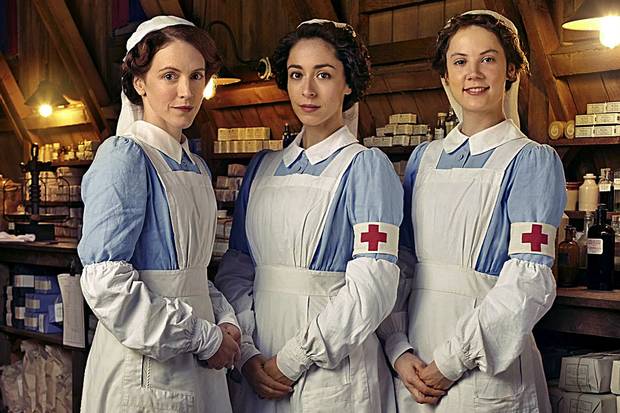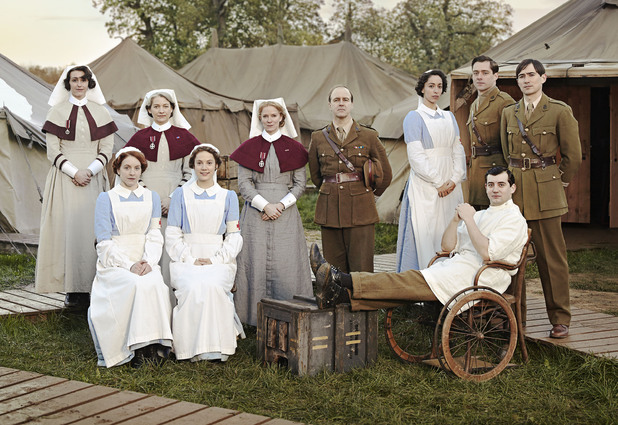
The newest mini-series on BBC1, The Crimson Field, takes place during the First World War and focuses on three young women who are members of Britain’s VAD (Voluntary Aid Detachment).
We see the ladies in a tent acting as the field hospital somewhere in the trenches off the coast of France. The mini-series tells the story of the women as they act as volunteers on the Western front. The women are good natured and appear to have walked out of their gentile life into the horrors taking place on the battlefields.
The nurses must treat and care for soldiers who have severe wounds, post-traumatic stress, and gangrene—all while they work out of leaky tents and shabby huts.
Sarah Phelps is the writer for the series and she shares how the women were originally preparing for their futures as wives and mothers, and now they were thrust into the middle of a bloody war. The women were certainly unprepared for the horrors that they were to face.
The first drama the BBC commissioned will mark the centenary of the outbreak of WWI. The Crimson Field will air on Sunday evenings on BBC1 in April and is aimed toward people who watch Call the Midwife and Downton Abbey, while still staying true to the social standards of the era.
Phelps adapted the Gothic version of Great Expectations that previously aired on the BBC. The show starred Gillian Anderson who portrayed Miss Havisham. Phelps also acted as a regular writer on EastEnders and had dealings with the radio soap, Westway. It is said that she has an uncanny ability to get in touch with the characters she creates and can understand what makes them special.
The show begins during 1915 after the call for volunteers first alarmed. The rule was that women who volunteered had to be over 23 years old and single. Patriotism was a ploy and most who volunteered had a secret reason for wanting to volunteer.
When we first see the character, Kitty (played by Oona Chaplin), we see her throwing away a wedding ring. We meet Rosalie (played by Marianne Oldham) being shamed for being the eldest daughter who remains unwed.
This is Oldman’s first television role. In person, Oldman is a lovely young woman, which only makes her portrayal as an uptight Rosalie all the more impressive. She is best known for tackling Chekhov at the Arcola and Southward Playhouse. When she is on the screen, it is said she possesses stillness and interiority onto the set.
In order to write the series, Phelps surrounded herself with letters and diaries from the era. The works also include Lyn MacDonald’s seminal history of field nurses, “The Roses of No Man’s Land.” Because of the material, the story is told from the female perspective.
A lot of the humor comes from seeing the new recruits try to fit in with seasoned professional nurses. There are parallels with modern offices. Spooks star, Norris, was a stern and pursed-lipped as Matron. Fox is a passive-aggressive deputy who has recently been passed over for a promotion.
Donning a tightly strung corset and making beds, pushing trolleys across soggy fields, Oldham had a sense of what life would be life for the women of the VAD.
Every episode begins with seeing the nurses care for the newest round of soldiers who were wounded in combat. Not only do they care for the soldiers, they also treat civilians and even enemies. Phelps insisted the drama remain unbiased.
Although the topic is quite brutal, the series is gorgeous. The hospital appeared like a safe haven in the middle of all the blood and gore. For the men, it was a relief to be wounded.
The reality for the nurses was very different. There were no transfusions or medications. Many of the men came into the hospital with a venereal disease.
The volunteer nurses had to eradicate all the signs of femininity, they were not to draw any attention from the men. It was forbidden to have any relationships with the soldiers.
For many of the women in the VAD, being sent to France was life-altering. The Crimson Field is reminiscent of a soap opera but it also reflects world events.
The First World War was the beginning of modern psychiatry and plastic surgery. The medics were forced to save lives in primitive conditions. It also represented the end of the formality of the Edwardian era. While the young ladies emptied bedpans and nursed the wounded soldiers, previous concerns were fleeting.
In three years from 1915, women older than 30 years old would be able to vote. As the Crimson Field shows, females with only a few months of training are more than ready to take over the world.
